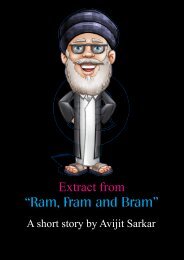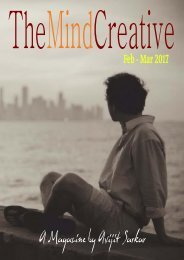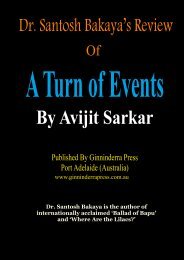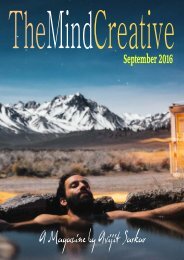Anthony Gonzalves - The Passing Of A Genius
The life story of Anthony Gonsalves - one of the pioneers of Western music in Bollywood.
The life story of Anthony Gonsalves - one of the pioneers of Western music in Bollywood.
Create successful ePaper yourself
Turn your PDF publications into a flip-book with our unique Google optimized e-Paper software.
Anthony Gonsalves
The Passing of a Genius
By Avijit Sarkar
When Amitabh Bachhan jumped out of a giant egg in the film Amar, Akbar, Anthonly and broke
into the popular song “My Name is Anthony Gonsalves”, I am sure that hardly anyone realized
that the song was specially created by Pyarelal (of Laxmikant-Pyarelal fame) as a tribute to his
mentor Anthony Prabhu Gonsalves.
Anthony Gonsalves was born in Majorda, Goa. His father, a choir master, trained him on the
violin at a very early age in Western classical music and urged him to play the violin at the village
church. A child prodigy, Anthony was appointed the choir master at the church at the age of
twelve. By the time he was sixteen, he was already a seasoned musician and in 1943 he decided
to go to Bombay to make his living as a musician. In tinsel town, his skill and talent were
recognized quickly and he soon made a name for himself as music teacher and also joined as a
violinist with music director Naushad.
In those days, many musicians in the film industry would play music “by the ear” rather than read
music at recording sessions. It was quite often that music directors would bring together a band of
10 to 15 good musicians and then practice a song diligently with them so that in the recording
session the music would then be played from memory. All this changed as Goan musicians
descended upon Bombay. Trained in Western styles and techniques, these amazing musicians
from Goa, brought with them new skills and new instruments. They would read and write music
and their virtuosity in harmony made them invaluable assets for music directors. From within this
elite group, Anthony Gonsalves was in the forefront. With him came an entirely new method of
“arranging” music. He was soon being hired by leading music directors to arrange their music
scores for films.
Anthony, was however much more than just a music arranger. His genius manifested in more
ways than one. While other Goan musicians laid their training and focus on Western music,
Anthony started focusing on Indian classical music. In later years, he went on to say “Indian
classical music struck me very hard in my heart and my mind. Melodically and rhythmically it is so
rich.” He soon came in contact with legendary classical musicians like Pannala Ghosh (the
flautist), Pandit Ram Naryan (the sarangi wizard) and Ustad Inam Ali Khan (the tabla maestro).
They would often spend evening jamming together and co-relating the two styles in what is today
known as “fusion” music of the East and West. He immersed himself in Indian classical and
Western “jugal-bandis” and at the same time produced some brilliant students from his flat on
Linking Road in Bandra. Two of his students, Pyarelal and R.D. Burman, would later be termed
as legends themselves in the Bollywood music industry.
Such was his measure of talent that soon he started writing symphonies based on Indian ragas
with names like Sonatina Indiana, Concerto in Raag Sarang andConcerto for Violin and
Orchestra in Todi Thaat. His dream was fulfilled when in 1958; he funded and launched a 110
piece orchestra called “The Indian Symphony Orchestra” with Lata Mangeshkar and Manna Dey
as the solo singers. Anthony maintained that this was not an experiment in fusion but a
symphonic form of ragas with orchestration and choir. He later said that he did this for the love of
music and to demonstrate the richness of traditional Indian classical music.
The Indian Symphony Orchestra was received with a lot of enthusiasm by the listeners in Mumbai
but the interest soon died down. According to musicologist Rajan Parrikar, “An episode in 1959
was to injure Anthony‘s psyche, one from which he never quite recovered. The then-Minister of
Information and Broadcasting, B.V. Keskar, in a display of bigotry, refused to let
Anthony compose a score for an animation film because Keskar held the barbaric view that
“Indian Christians should not even be provided with jobs.”
However, the experiment gave a boost to his reputation and in 1965 he received a fellowship at
Syracuse University (New York) to study and teach music. It was time for Anthony to leave the
shores of India in search of greater fulfillment in distant lands. In the USA, he trained his new
students the finer points of Indian music, as also wrote several small pieces of music, double
violin concertos and two sextets with the clarinet and piano. He was further requested to send his
music books to the Library of Congress in Washington, which eventually he did. The Rockefeller
Foundation sponsored Anthony Gonsalves throughout his stay in the USA, thus enabling him to
travel across the country and teach at various American Universities. He even did a stint in
Hollywood, writing music scores for films such as ‘Silk Screen’. The pinnacle of glory for Anthony
Gonsalves however came with his attendance at the the Tanglewood Music Festival where he
met such renowned performers as Adrian Bold and Eric Lansdorf, who saw him as a legend in
the music world. It has been documented that Adrian Bold thanked Anthony Gonsalves at the
festival for teaching Indian music to the world.
What happened to Anthony Gonsalves in the US still remains a mystery. He never spoke about
his days there. In fact, he left India at the peak of his career and when he returned a decade later,
he never informed anyone about his way back home. His peers and other musicians in the
industry had no idea that he had returned. The simple fact was that Anthony never came back to
the Bollywood music industry and retired as a recluse in his small Goan village. Later
documentary film makers and journalist found it extremely hard to trace him down. There are
many rumors that he suffered a mental breakdown when he realized that he would not be able to
make his mark in the Americas as a composer.
A 58-minute film on the genius of Gonsalves, was later produced and directed by National-award
winning filmmaker Ashok Rane. This documentary also premiered at International Film Festival of
India (IFFI). After the screening, Rane had one comment to make “It is a very sad day for the
music industry. Our musicians, who were once the soul of our music, need to be valued more.”
That statement from Rane was definitely an under-statement.
Anthonly Gonsalves had written over one hundred symphonies (most of which are still lying
around in an old rusty trunk), arranged and played music in over a thousand songs in 250 films in
Bollywood. He has arranged music and functioned as a lead violinist for music directors like
Pankaj Mullick, S D Burman, Khayyam, Khemchand Prakash, Madan Mohan, Salil Chaudhary
and many more. His immortal music arrangements still ring in our ears through compositions like
Jiya Bekarar Hai, Saiyan Dil Aana Re, Jyoti Kalash Chalke, Aayega Aanewala, Ye Raat Ye
Chaandni Phir Kahan and Dharti Kahe Pukaar Ke.
In Rane’s remarkable documentary film Anthony Gonsalves say “A song is like a beautiful
woman. All she needs is ornamentation and this is given to the beauty through proper
orchestration and music arrangement.”
Anthony was once described by his contemporaries as musician who was “far ahead of his time”
and as the person who gave Bollywood the international musical image that the industry is known
for. Even then, awards and accolades passed him by. Other than Amitabh’s song on screen, the
first award (the Karmaveer Puraskaar) came too late. Anthony was 82 and struggling in a little
village. In the end, the Bollywood music industry once again turned its back on a legend. Fending
for himself, Anthony Prabhu Gonsalves died on 19 th January 2012 – secluded from the world of
music that he loved so dearly; a world that so easily forgets the very foundations on which it
stands.
















